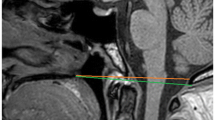Abstract
Basilar invagination (BI) is characterized by rostral dislocation of the cervical spine toward the skull base. The craniometrics of the skull base have shown significant differences among craniocervical junction malformations. The sphenoid bone is the center of the skull base; however, no study has evaluated this bone in cases of BI. This was a cross-sectional study of MRI databanks from two institutions of the author’s practice between 1985 and 2020. The craniometrics of the sphenoid bone were measured in BI patients and controls. Fifty-eight MRIs were selected, including 28 BI patients and 30 controls. The mean sphenoid crest-clivus length was 32.66 ± 4.7 mm in the BI group and 29.98 ± 3.0 mm in the control group (p = 0.01). The mean sphenoid planum-top of Dorsum sellae length was 28.53 ± 3.7 mm in the BI group and 26.45 ± 3.2 mm in the control group (p = 0.02). The mean tuberculum sellae–sphenoid floor height was 18.52 ± 4.4 mm in the BI group and 21.32 ± 2.9 mm in the control group (p = 0.00). The mean sella turcica–sphenoid floor height was 10.35 ± 3.8 mm in the BI group and 12.24 ± 3.5 mm in the control group (p = 0.05). The mean clivus length was 29.81 ± 6.3 mm in the BI group and 40.86 ± 4.2 mm in the control group (p = 0.00). The mean sphenoid length was 58.34 ± 7.4 mm in the BI group and 67.31 ± 6.0 mm in the control group (p = 0.00). The mean sphenoid angle was 116.33 ± 8.7° in the BI group and 112.36 ± 6.9° in the control group (p = 0.05). The BI sphenoid bone has shorter vertical dimensions and longer horizontal measures. This morphology promotes a flattening of the sphenoid angle. The sphenoid bone is significantly altered in BI, favoring the congenital hypothesis in the pathophysiology of this disease.






Similar content being viewed by others
Data availability
The data that support the findings of this study are available from the corresponding author (RVB), upon reasonable request.
References
Botelho RV, Botelho PB, Diniz JM (2020) Where does the cranial base flexion take place in humans? An Acad Bras Cienc 92(1):e20190825. https://doi.org/10.1590/0001-3765202020190825
Botelho RV, Ferreira ED (2013) Angular craniometry in craniocervical junction malformation. Neurosurg Rev 36(4):603–10. https://doi.org/10.1007/s10143-013-0471-0
Cendekiawan T, Wong RW, Rabie ABM (2010) Relationships between cranial base synchondroses and craniofacial development: a review. Open Anat J 2:67–75
Chamberlain WE (1939) Basilar impression (platybasia): a bizarre developmental anomaly of the occipital bone and upper cervical spine with striking and misleading neurologic manifestations. Yale J Biol Med 11(5):487–96
Chen XY, Chen W, Zhao JL, Dong HR, Ln Zhou, Xiao X, Chen G, Che XM, Xie R (2023) Surgical outcomes of basilar invagination type B without atlantoaxial dislocation through simple posterior fossa decompression: a retrospective study of 18 cases. Acta Neurochir (Wien) 24. https://doi.org/10.1007/s00701-023-05625-3
Couly GF, Coltey PM, Le Douarin NM (1993) The triple origin of skull in higher vertebrates: a study in quail-chick chimeras. Development 117(2):409–29. https://doi.org/10.1242/dev.117.2.409
Di Ieva A, Bruner E, Haider T, Rodella LF, Lee JM, Cusimano MD, Tschabitscher M (2014) Skull base embryology: a multidisciplinary review. Childs Nerv Syst 30(6):991–1000. https://doi.org/10.1007/s00381-014-2411-x
Jeffery N, Spoor F (2004) Ossification and midline shape changes of the human fetal cranial base. Am J Phys Anthropol 123(1):78–90. https://doi.org/10.1002/ajpa.10292
Joaquim AF, Evangelista Santos Barcelos AC, Daniel JW, Botelho RV (2023) Chamberlain’s line violation in basilar invagination patients compared with normal subjects: a systematic literature review and meta-analysis. World Neurosurg 173:e364–e370. https://doi.org/10.1016/j.wneu.2023.02.057
Nascimento JJC, Neto EJS, Mello-Junior CF, Valença MM, Araújo-Neto SA, Diniz PRB (2019) Diagnostic accuracy of classical radiological measurements for basilar invagination of type B at MRI. Eur Spine J 28(2):345–352. https://doi.org/10.1007/s00586-018-5841-4
Nemzek WR, Brodie HA, Hecht ST, Chong BW, Babcook CJ, Seibert JA (2000) MR, CT, and plain film imaging of the developing skull base in fetal specimens. Am J Neuroradiol 21(9):1699–706
R core Team (2021) R: a language and environment for statistical computing. R Foundation for Statistical Computing. Available via DIALOG. https://www.R-project.org/
Shah A, Serchi E (2016) Management of basilar invagination: a historical perspective. J Craniovertebr Junction Spine 7(2):96–100. https://doi.org/10.4103/0974-8237.181856
Smith JS, Shaffrey CI, Abel MF, Menezes AH (2010) Basilar invagination. Neurosurgery 66(3 Suppl):39–47. https://doi.org/10.1227/01.NEU.0000365770.10690.6F
Vet AD (1940) Basilar impression of the skull. J Neurol Psychiatry 3(3):241–50. https://doi.org/10.1136/jnnp.3.3.241
Author information
Authors and Affiliations
Contributions
All authors contributed to the study conception and design. Material preparation, data collection, and analysis were performed by Ítalo Teles de Oliveira Filho and Ricardo Vieira Botelho. The first draft of the manuscript was written by Ítalo Teles de Oliveira Filho and all authors commented on previous versions of the manuscript. All authors read and approved the final manuscript.
Corresponding author
Ethics declarations
Ethics approval
The study was approved by the Research Ethics Committee (Instituto de Assistência Médica ao Servidor Público Estadual – IAMSPE. CAAE: 07284212.0.0000.5463).
Consent to participate
The requirements for waiver of informed consent were appropriate for this MRI databank study.
Competing interests
The authors declare no competing interests.
Additional information
Publisher's Note
Springer Nature remains neutral with regard to jurisdictional claims in published maps and institutional affiliations.
Rights and permissions
Springer Nature or its licensor (e.g. a society or other partner) holds exclusive rights to this article under a publishing agreement with the author(s) or other rightsholder(s); author self-archiving of the accepted manuscript version of this article is solely governed by the terms of such publishing agreement and applicable law.
About this article
Cite this article
Filho, Í.T.O., Botelho, R.V. The role of sphenoid bone in basilar invagination pathophysiology. Neurosurg Rev 46, 322 (2023). https://doi.org/10.1007/s10143-023-02227-6
Received:
Revised:
Accepted:
Published:
DOI: https://doi.org/10.1007/s10143-023-02227-6




